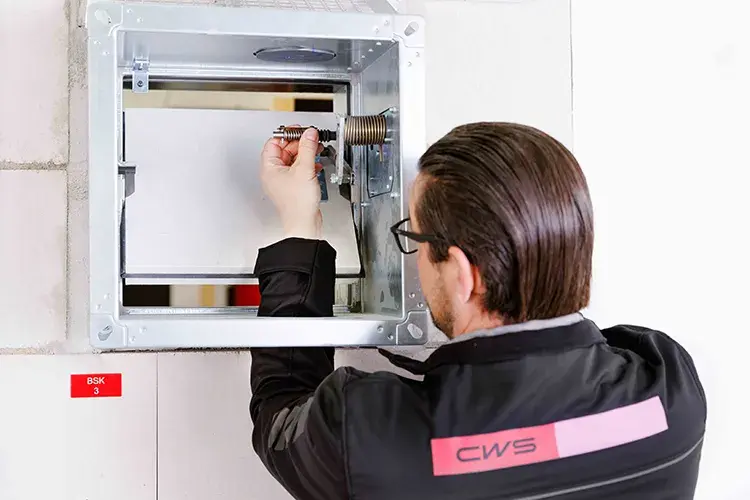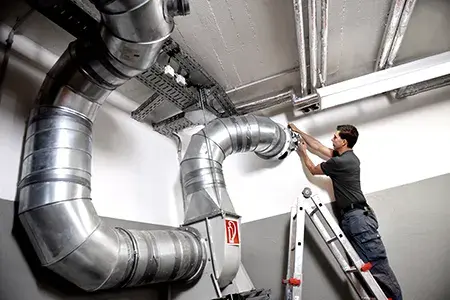Already in the planning phase of a new building or a building renovation, fire protection devices must be planned according to the legal guidelines and manufactured during the construction phase (interim bulkheads). Fire barriers, fire protection ducts, fire protection dampers and similar products from the field of preventive structural fire protection reduce the spread of fire and smoke via media such as lines, cables or pipes. Fire compartments ensure that other floors or necessary escape routes such as stairwells remain accessible.
CWS Fire Safety supports you in structural fire protection and carries out all work according to the component classifications from the fire protection concept, building permit or according to state or special building regulations as well as according to DIN 4102 (fire behaviour of building materials and components). The work is carried out in accordance with the respective building authority approval of the product manufacturer.
When renovating existing buildings, there is also the risk of encountering building materials containing harmful substances such as asbestos. Analysing, dismantling and properly disposing of these building materials is one of our tasks. Contact us, we will support you!
Products in structural fire protection
CWS plans and installs fire protection products in your building, whether renovation or new construction. We are certified as installers for a variety of solutions in structural fire protection. We also carry out inspections, maintenance and the remediation of hazardous substances.
Maintenance in structural fire protection

Operators of buildings are obliged to keep them in a technically perfect condition. All structural fire protection measures are subject to a maintenance and inspection obligation, such as fire dampers. Fire dampers for ventilation systems must be inspected every six months after new installation and annually after two defect-free follow-up inspections. This is based on:
- DIN EN 15650: Standard for the ventilation of buildings - fire dampers,
- DIN EN 13306: Standard for maintenance, and
- DIN 31051: Standard for the basics of maintenance.
In addition, fire dampers are subject to mandatory testing in accordance with TPrüfVO. If you have a maintenance contract with our CWS Fire Safety Team, we will remind you in good time.
Cooperation with various manufacturers
In structural fire protection, we work closely with the leading material manufacturers. They constantly provide us with forward-looking, technically tested and qualified high-quality fire protection products.
|
|
|

FAQ - Preventive structural fire protection
The planning and implementation of structural fire protection measures raises many questions. We have answered the most frequently asked ones below.
What regulates structural fire protection?
Each federal state’s Landesbauordnung (LBO), the federal states’ Muster-Verwaltungsvorschrift Technische Baubestimmungen (MVV TB) and DIN, ASR and VDI standards set the rules.
What all belongs to structural fire protection?
Structural fire protection includes the construction or adaptation of structural systems to prevent fire from starting and spreading. For example, separating fire compartments with fire-resistant walls, doors and gates or fire dampers and bulkheads is part of structural fire protection. In addition, the planning and implementation of escape and rescue routes, extinguishing water supply or areas for rescue forces play a role.
Where is remediation defined?
The Technical Rules for Hazardous Substances (TRGS) and the Guidelines to the Ordinance on Industrial Safety and Health (LASI) specify exactly who may handle which material, when, how and where.
Who is allowed to seal off cables and pipes?
As a rule, penetration seals should only be installed by trained personnel. Combination bulkheads, in which cables and pipes of various supplies such as water, electricity and air conditioning are sealed off at the same time, are the responsibility of experts. This is because they have been certified by the material manufacturer and are registered by name with the DiBt, the German Institute for Building Technology.
When is there a risk of coming into contact with asbestos when it comes to fire safety?
Asbestos was processed in buildings until 1989 in the form of bulkheads, seals and many other building materials - sometimes invisibly. Since 1989, the processing of asbestos has been prohibited by law. If your fire dampers were installed before 1989, for example, you must have them refurbished by a specialist company. Our experts will be happy to do this for you.
How can I identify asbestos?
Only a trained eye can detect asbestos. The pollutant is odourless and does not emit radiation. It can only be measured and evaluated by room air measurements or by sampling by a certified, accredited laboratory. We would be happy to carry this out for you.
